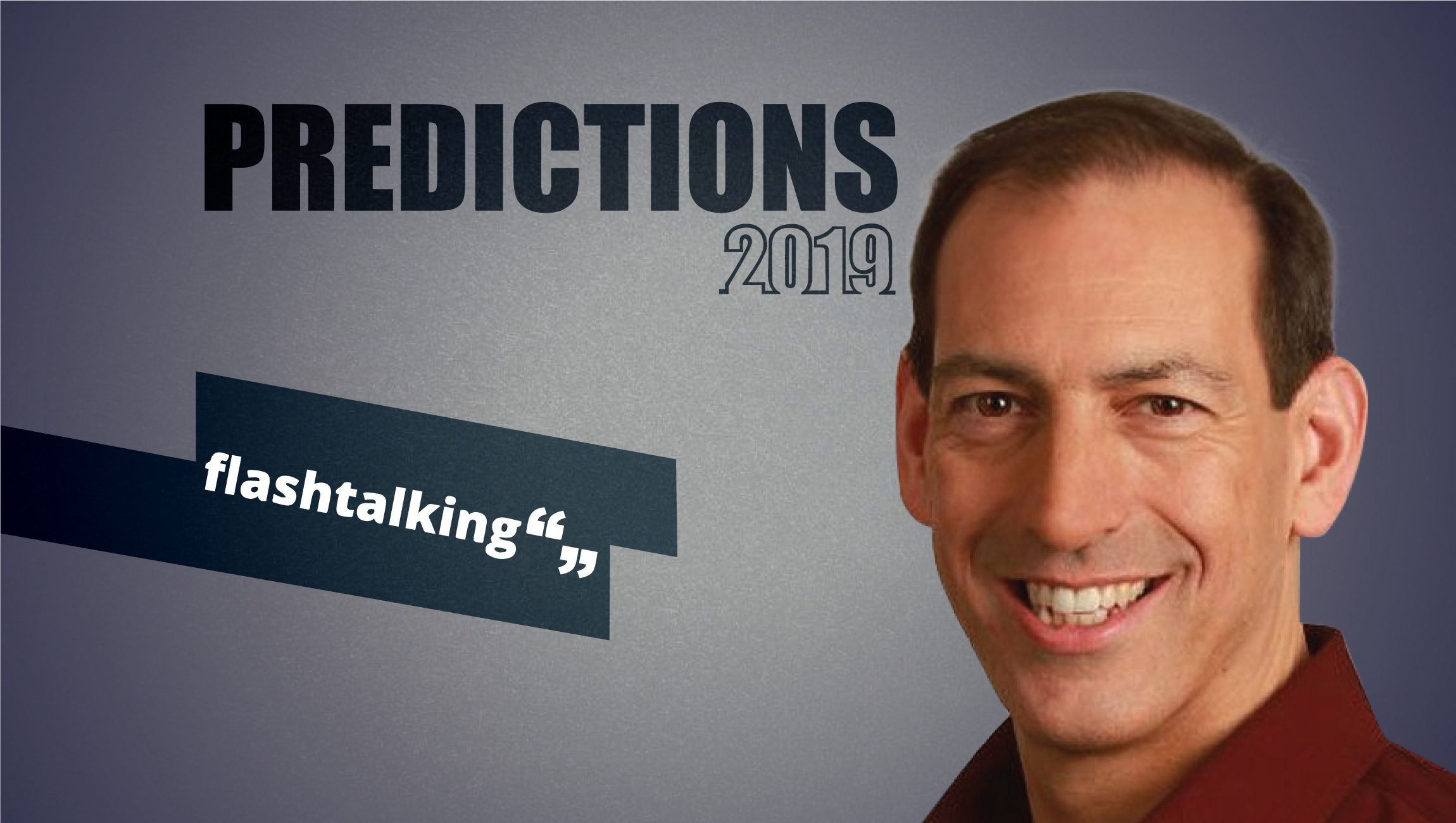Tell us about your role at Flashtalking and how did you start here.
Today, I’m CEO of Flashtalking, but I got into digital back in 1994, basically the earliest days in the industry. GM O’Connell, the Founder of Modem Media, which was the first-ever digital agency, recruited me out of Pepsi by convincing me that the story of advertising in the digital space was yet to be written. This was his pitch to me, “Help make the rules for a whole new part of the industry, remake the landscape.” This was exciting to me. He sold me on the idea that if I joined Modem, I could effectively become the next David Ogilvy for the digital age!
I saw GM at a holiday party in December, and his observation was that there is a vast opportunity opening up again, for voice to interface with ads, which can again open a whole new approach to creative. This really gets me excited. After I left Modem, I spent 11 years focused on the analytics side of our business. I came to Flashtalking in 2015 because I missed being involved with the creative. Now with Machine Learning-based creative analytics and voice activated ads becoming a reality, I think we are on the cusp of what will be revolutionary, and I’m really excited to explore where the path takes us in 2019.
What was the most impactful event in technology for you in 2018? How did the event/moment change the way you think about business?
For Flashtalking, the DoubleClick ID going away has been the most seismic change. We’ve long believed that there was an opportunity to bring the market better data than what DoubleClick was offering. We’ve been focused over the last few years on developing products, whether it’s fTrack or IDConnect, that build on the belief that advertisers should have better data and be able to make better use of that data, than what one could do with the DoubleClick platform.
It was so entrenched after so long and we saw the way people operated. Talking to clients about ripping out DoubleClick was just not a discussion that people were prepared to have. And, now here we are, and it’s huge. When the DoubleClick ID went away in Europe due to GDPR, the whole infrastructure around data in the industry just crumbled.
This has forced clients to reconsider their AdTech choices, so it’s been tremendously good for us. Advertisers and agencies are now looking at all these data related innovations and products that we built and saying, “Oh my goodness, this stuff is really differentiated.” For me, it has opened up the aperture in terms of what we can do. It’s encouraged us to be much more aggressive in the market place and to hold ourselves up as a real and genuine alternative.
What is the current state of “Creative Measurement and Creative Analytics” technologies? How do you fit into this landscape?
The state and degree of measurement in creative analytics? I would argue that there wasn’t any until Flashtalking introduced our creative analytics products. There has been nothing in the industry. This has been the biggest blind spot or black hole for our entire industry. We’ve had 20 years of people judging creative based on click-through rate with little proof…and it’s just wrong — if not counter productive.
Until we launched our Machine Learning-based creative analytics product, no one offered another alternative. So, how does Flashtalking fit into the landscape? We are standing alone in a desert. I’m really happy to say: we are the only game in town with a real solution here.
What opportunities and challenges did you and/or Flashtalking identify at the start of 2018 and have things worked out as planned?
One of the big accomplishments in 2018 was the Spongecell acquisition and integrating Spongecell and Flashtalking as one company. That was certainly a big focus of the year and the focus coming into that year. This acquisition was driven by a desire to upgrade our creative build tools and to take advantage of some of the really smart user interface concepts that Spongecell had developed.
We’ve done that. It took us a whole year, but we exit 2018, going into 2019, having fully integrated — plus some. For anybody who has been through integration of another company, to do that in 12 months — they know. It’s a lot. It’s something of which I’m really really proud. It’s not easy.
The other really big thing for us in 2018 was the launch of the new campaign management platform. This was a bottoms-up rebuild of our entire ad server infrastructure in order to position us for the future, in this new landscape. Of course, the work was well underway before Google’s announcement, so we were prepared for that.
Overall, seamless strategic integrations with top partners are core to our market leadership. One of the distinguishing factors around our campaign manager is that it is built on an API layer that allows us to easily integrate with partners. Many of our top partnership efforts began in 2018 and will come to fruition in 2019. Our goal is to have Flashtalking operate seamlessly with the strongest independent members of the ad tech ecosystem, so that advertisers have a seamless experience that doesn’t give up anything in terms of workflow versus an integrated stack.
As a data activation platform, how does Flashtalking build on its expertise to connect cross-channel experiences with programmatic technologies?
We are a data activation platform, but not in the way most people think of one. To me, a data activation platform has two pieces. You need to have high-quality data coming into the platform, and you need to be able to activate on it…to do something meaningful with it. On both of those fronts, we’ve forged a unique path because we’ve built many tools to create better data and to integrate data sources — and that’s really unique. The idea that there’s better data coming in makes a huge impact. Then, obviously we have the ability to activate it from a creative standpoint, which is what Flashtalking has been about for a long time.
Most people talk about data activation platforms and think about the DSP. Activation means buying. But DSPs don’t have the capability to create, to integrate or to manage the data streams themselves. It’s someone else’s job to turn data into an asset they can consume. I think Flashtalking’s unique in terms of sitting on both sides of that equation. We have these great tools to create, to capture and to align data so we can feed better data into the process. At the same time, we can use that data after the ad is purchased to get the right message in front of the consumer. It’s a unique combination.
What predictions do you have in the way Marketing and AdTech companies now apply data science (especially Location Data) to enable personalized marketing efforts?
When I’m talking to clients, I point out that they’ve spent a lot of time as a team focusing on understanding their customers. Whether that’s assembling your first-party data or purchasing all manner of third-party data, that’s all usually about understanding who their consumers are. That’s really important, but it is not the whole story. To achieve successful personalized advertising, you also need to understand who the person is and the context and the circumstance in which the consumer is seeing an ad. Then, you have to be able to manage that message over time as context and circumstance change. Who, plus context, plus circumstance, plus time. Our approach focuses on that complete equation.
But, let me break those down a little bit. The “who” is relatively easy. Then, the context: is they on a mobile device, or a desktop? Are they trying to buy something online? Is there a particular kind of content that they’re engaging with that colors the way that they’re going to interpret the message? Then, the circumstance is about what is happening around them physically. Are they at home, or are they in a car? Are they caught in the rain? Are they standing in an auto dealership?
Those three elements, plus time, are the building blocks for personalized advertising. You’ve got to know the who, you have to know their context, and you also have to know their circumstance each time you deliver an ad. location is important to both context and circumstance, because you can infer a lot from the context either from their location alone or in combination with other data points. This combined with knowing what device they are on, whether they are on a cellphone, a desktop or a tablet gives a lot of insight into their context and their circumstance.
Incorporating this kind of thinking and levels into a messaging strategy and creative concept requires a new skill set. It is a paradigm that is just not yet established among creative teams or clients. There’s an educational process that needs to happen in the industry to be able to fully take advantage of what this technology makes possible. Flashtalking is devoted to this.
I should say also, we continue to evolve — or should continue to evolve — our understanding of audience-based buying. There was an article by Michael Clark and Beeby Clark+Meyler not too long ago. It was the first articulation that I’ve seen that was really thoughtful about what audience-based marketing is today.
I call that out because that’s another one of these buzz phrases that’s been flying around for two years, but then I see people doing the same old stuff that they’ve always been. You are just buying targeted line items with a DSP, with different bidding strategies — woo hoo! That’s not audience-based buying — that’s media buying.
What I just loved was how Michael went back to the basics of saying: “Who are your audience segments, what’s your opportunity with them, what do you need to unlock your opportunity — and then, how much do you want to invest with them?” That’s all work you should be doing as sound strategic practice, well before you build a line item with your DSP.
But, frankly, I don’t see people doing it. I don’t see clients doing it. I don’t see agencies doing it. That needs to change if we’re going to ever see the benefit of all the technology we’ve invested in.
Would you agree that it was a year of mega-acquisitions in MarTech? Which acquisition news excited you the most?
Obviously, there was AT&T buying Appnexus, and Time Warner and DirecTV, those certainly would qualify as major acquisitions in terms of their size and long term impact. The “mega” nature of those would be due to their size. For me it’s not the size that is interesting. The verticalization that is emerging in terms of content and delivery is really interesting as a trend.
The other side of the spectrum is the acquisition of AdTech companies by private equity firms. That’s for me maybe more interesting in that traditionally AdTech companies are not that profitable. A few have been, but most lose money. Traditionally, private equity firms only acquire profitable companies because they want to lever them up with debt. So I look at deals like Integral Ad Science and DoubleVerify. I see deals like that where private equity is essentially betting on the future of ad tech. That’s really exciting to me.
Would we see a resolution in brand safety and ad fraud standards? What preventive measures could ad tech vendors take to remove brand-safety issues?
I get upset every time I hear this stuff because there are plenty of tools out there for brand safety and fraud. But like any tool, the tool by itself is only as good as the responsible user. Frankly, I think the agencies and the clients are just really lazy in this area because the agencies don’t want to do the work to curate private marketplaces. They want to be able to go out on the open web and just buy things quick and easy and be able to say, “I’ve bought the tool so I’ve done everything I can do.” And that’s just not good enough.
The fact of the matter is, there are bad guys out there and there’s a lot of money to be made by them. They’re not going to go away. So you’re going to have to resign yourself as an agency and a client to do more than just check the box. You’re going to have to develop some strategies to focus on inventory quality. I think that that means going back a little bit to say, “How do I cut deals with reputable publishers? I may still want to transact with programmatic pipes, but at least I want to know who I’m doing business with.” Yes, that’s more work.
Which new buzzword that you are keenly following and why?
Identity. That’s a great buzzword for 2019. People have thrown the term around without a lot of definition, so people impute their own assumptions and definitions around it, so it means different things in different situations. But it is on everyone’s lips nonetheless. There was this great moment where our team was talking to the head of analytics at one of the agencies. He was insisting that the DoubleClick report that he had was showing “people-based” data. We explained to him why it didn’t. But, he was certain, “Yes, Google told me they do ‘people-based.’” So we asked: “They do people-based what? What exactly does that mean?”
Here’s the reality. They may (or may not) deliver ads based on people but you don’t get to see that data. That’s not the data that you get out of DoubleClick. When the client ran FTrack and actually saw how different the data was, the guy was flabbergasted. He couldn’t believe that Google had misled him. I don’t think Google was lying to him. I think that a Google rep was throwing around the term and he was making a whole host of assumptions about what it meant. And he was way off base.
The above illustration is why “identity” or “people-based” can be terms that are just tossed around without questions and context. We don’t yet have a good vernacular, and clients and agencies are not yet asking the hard questions. And that’s a tragedy.
My hope, more specifically, is that people will stop making assumptions about what the walled gardens are giving them. They say that they have deterministic data — they do — but that doesn’t mean that you as the advertiser are getting the benefit of it.
Any advice to the CEOs and CMOs of AdTech companies.
At least in our industry, I would say innovate, innovate, innovate. You can’t stop innovating for a moment. The rate and pace of change are only going to accelerate, so you’ve got to run fast.
Second, your “product” is more than the tech that you provide,your product is the intellectual capital around how to use the tech and the people who help make it real for your customers. Don’t be so focused on just the tech, that you ignore the intellectual capital surrounding it and the people needed to support it. Especially in marketing, clients and agencies need support, so don’t think SAS means Sold without Any Support. That’s a mistake the big software companies are making. You don’t have to follow suit. Make the whole of these things the intellectual capital for your customers.
John Nardone is the CEO of Flashtalking. He is a first-generation ad tech pioneer serving as a founding board member of the Internet Advertising Bureau (IAB). Throughout his career he earned recognition within the advertising community for his ground-breaking work at Pepsi, Modem Media and Marketing Management Analytics (MMA). At MMA, he had a hand in establishing marketing mix modeling, illustrating his long-standing advocacy for marketing accountability. As CEO at [x+1], through its acquisition by Rocket Fuel, Nardone helped transform that business into a top-rated data management platform (DMP). Rocket Fuel acquired [x+1] for $230M in 2014. It was while running [x+1] that Nardone became a client of Flashtalking, and learned firsthand of its power as the art and science behind the perfect message.
![]()
Flashtalking is a data-driven ad management and analytics technology company, we use data to personalise advertising in real-time, analyse its effectiveness and enable optimisation that drives better engagement and ROI for sophisticated global brands.
Our platform leads the ad management and analytics market by providing advertisers with innovative products, services and support to create, activate and measure data-driven digital advertising across desktop, mobile and connected TV.
Flashtalking serves billions of ad impressions throughout the US, Europe and international markets. Regional offices are currently located in New York, San Francisco, Los Angeles, Chicago, London, Leeds, Sydney, Cologne, Hamburg and Amsterdam.











